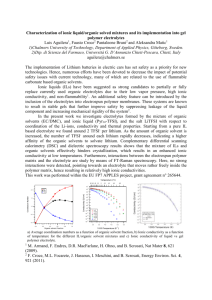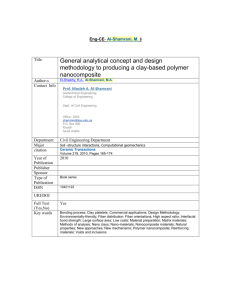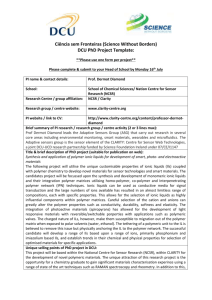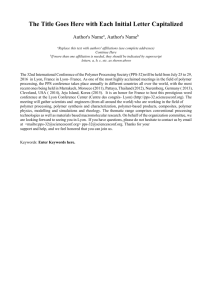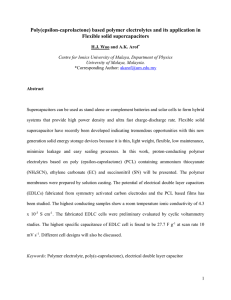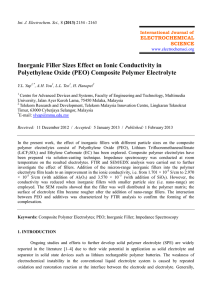Development of Nanocomposite Polymer Electrolytes (NCPEs) in
advertisement
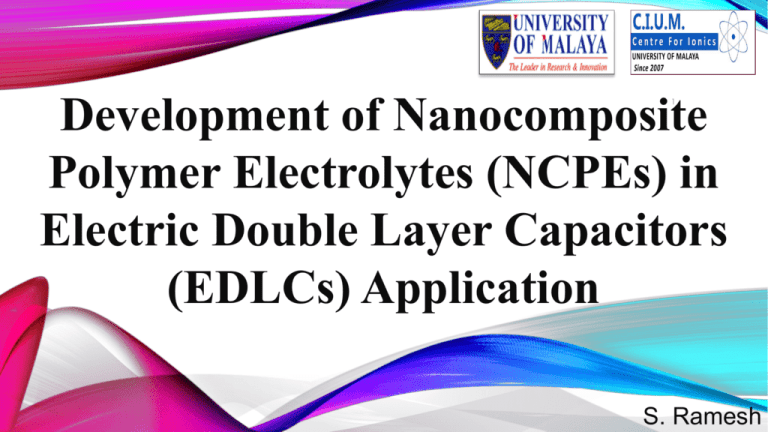
1 Development of Nanocomposite Polymer Electrolytes (NCPEs) in Electric Double Layer Capacitors (EDLCs) Application S. Ramesh 2 UNIVERSITY OF MALAYA, MALAYSIA 3 OVERVIEW 1) Introduction 2) Problem Statement 3) Literature Review 4) Methodology 5) Results and Discussion 6) Conclusions 4 INTRODUCTION 5 Light in weight Easy handling Thermally stable Safer Flexible Advantages of Solid Polymer Electrolytes Wider electrochemical stability Applications of Polymer Electrolytes Lithium ion batteries Sensors Fuel cells Solar cells Supercapacitors Electrochromic windows 6 7 Low ionic conductivity PROBLEM STATEMENTS Biopolymer Ionic liquids Environmentally unfriendly Polymer blending Mixed salt system Mixed solvent system Ionic liquids Plasticizers Fillers Fillers Polymer blending Low mechanical strength 8 Starch Natural Cellulose Chitosan Biodegradable polymer PVA Synthetic PLA PHA 9 LITERATURE REVIEW 10 Excellent tensile strength Environmentally friendly Non– toxic Excellent charge storage capacity Good chemical stability Excellent thermal stability High dielectric constant Biocompatible Advantages of PVA 11 Wider electrochemical potential window Non–toxic Excellent thermal stability Non– flammable Advantages of Ionic Liquids Superior electrochemical stability High ion content Non–volatile Plasticizing effect 12 Filler Inorganic Active • • • • • Lithium–nitrogen (Li2N) Lithium aluminate (LiAlO2) Lithium containing ceramics Titanium carbides (TiCx) Titanium carbonitrides (TiCxNy) Organic Passive • • • • • • • • • Graphite fibre • Aromatic polyamide • Cellulosic rigid rods (whiskers) Inert metal oxide Molecular sieves and zeolites Ferroelectric materials Rare earth oxide Solid superacid Carbon Nano–clay Heteropolyacid 13 Advantages of Fillers Enhance interfacial stability Enhance thermal stability Reduce Tg Increase cationic diffusivity Improve physical properties Decrease the crystallinity Improve morphological properties Lower interfacial resistance Improve long–term stability Reduce water retention 12 Supercapacitors Pseudo–capacitors Redox reaction •Conducting polymers •Metal oxide Electric double layer capacitors (EDLCs) Charge accumulation •Carbon Hybrid capacitors 15 ELECTRIC DOUBLE LAYER CAPACITORS (EDLCS) Longer cycle life Faster charge– discharge rate Higher power density Higher ability to be charged and discharged continuously without degradation Higher capacitive density Inexpensive 16 Disadvantages of AC CNT Hard diffusion Limit the accessibility of charge carriers High microporosity (pore dimension: <2nm) 17 18 MATERIALS MATERIAL Poly (vinyl alcohol) (PVA) 1–butyl–3–methylimidazolium bromide (BmImBr) Silica (SiO2) (70nm) Titania (TiO2) (40–50nm) Zirconia (ZrO2) (<100nm) Alumina (Al2O3) (<100nm) Distilled water ROLE Polymer Ionic liquid Fillers Solvent 19 METHODOLOGY 20 A) SAMPLE PREPARATION PVA+ BmImBr+ SiO2/TiO2/ZrO2/Al2O3 Stir and heat at 80 °C Cast on Petri dish EIS DSC LSV Al2O3 ZrO2 TiO2 SiO2 Formation of free standing polymer electrolyte 21 B) ELECTRODE PREPARATION Stir for several hours 80 wt.% of activated carbon 5 wt.% of carbon black 5 wt.% of carbon nanotubes (CNTs) 10 wt.% of poly(vinylidene fluoride) (PVdF) 1–methyl–2–pyrrolidone solvent Dip coating process 22 C) EDLC FABRICATION & CHARACTERIZATION Configuration: electrode/polymer electrolyte/electrode Figure 1: The fabricated EDLC using the highest conducting ionic liquid–added polymer electrolyte from each system. Cyclic Voltammetry (CV) Galvanostatic Charge–Discharge (GCD) 23 RESULTS AND DISCUSSION Ambient Temperature–Ionic Conductivity Studies (2.58±0.01)×10-4 S cm-1 -3.60 log [σ ( Scm-1 )] 24 -3.80 -4.00 -4.20 -4.40 -4.60 Si system (3.18±0.01)×10-5 S 0 2 4 6 8 10 Weight percent of SiO2 (wt. %) Figure 2: The logarithm of ionic conductivity of polymer electrolyte at different mass fraction of (a) SiO2 and (b) ZrO2. 25 Figure 3: The logarithm of ionic conductivity of polymer electrolyte at different mass fraction of (a) TiO2 and (b) Al2O3. Temperature Dependent–Ionic Conductivity Studies -2.00 y = -0.6449x - 0.4834 R² = 0.9954 -2.50 log σ [(Scm-1)] 26 -3.00 y = -0.7118x - 0.7307 R² = 0.9875 y = -0.721x - 0.7513 R² = 0.9863 -3.50 y = -1.0677x - 1.8396 R² = 0.9921 -4.00 -4.50 y = -1.3861x - 2.8442 R² = 0.9854 -5.00 2.5 2.6 2.7 Filler–free system 2.8 2.9 3 1000/T (K-1) Si system Zr system 3.1 3.2 Ti system 3.3 Al system Figure 4: Arrhenius plot of filler–free polymer electrolyte and filler–doped NCPEs. 3.4 27 Sample Activation energy, Ea (eV) 0.2751 –2.8442 Pre–exponential constant, A 1.43×10-3 0.2119 –1.8396 0.0145 Zr system 0.1431 –0.7513 0.18 Ti system 0.1413 –0.7307 0.19 Al system 0.1280 –0.4834 0.33 Filler–free system Si system Log A 28 Differential Scanning Calorimetry (DSC) Tg 9.06 °C Exo Heat Flow (W/g) 12.15 °C 14.11 °C 16.32 °C 18.12 °C Endo -20 -15 -10 -5 0 5 10 15 20 25 30 35 40 45 50 55 60 65 70 75 80 85 90 Temperature(°C) Si system Zr system Ti system Al system Filler–free system Figure 5: Glass transition temperature (Tg) of polymer electrolytes. 29 Tm Figure 6: Crystalline melting temperature (Tm) of polymer electrolytes. 30 Tc H m Xc 100% H m Heat of Fusion (Jg-1) 719.7 Relative crystallinity (%) 100 358.7 50 Zr system 287.6 0.40 Ti system 217.1 0.30 Al system 203.3 0.28 Filler–free system Si system Figure 7 : Crystallization temperature (Tc) of polymer electrolytes. Linear Sweep Voltammetry (LSV) 31 1.2 V 2.2 V Si system Filler–free system 2.0 V 2.3 V Zr system 2.2 V Ti system Figure 8: LSV response of the most conducting polymer electrolyte from each system. Al system Cyclic Voltammetry (CV) 32 Filler–free system i C sp sm 0.15 F g-1 1.74 mF cm-2 i C sp sA (a) Figure 9: Cyclic voltammogram of EDCL containing the most conducting polymer electrolyte from (a) filler–free system and (b) Si system. 33 Figure 10: Cyclic voltammogram of EDCL containing the most conducting polymer electrolyte from (a) Zr system, (b) Ti system and (c) Al system. 34 Galvanostatic Charge–Discharge Analysis (GCD) Csp Si system (a) I m dV dt Csp dV 2 E 2 (b) 1000 3600 I dV P 1000 2 m td 100 tc Figure 11: Galvanostatic charge–discharge performances of EDLC containing (a) Si system and (b) Zr system over first 5 cycles. 35 Ti system 4.34 F g-1 (a) Al system 8.62 F g-1 (b) Figure 12: Galvanostatic charge–discharge performances of EDLC containing (a) Ti system and (b) Al system over first 5 cycles. 36 System Specific discharge Coulombic Energy capacitance, Csp efficiency, η density, E (F g-1) (%) (W h kg-1) Si system 2.58 86 0.18 Power density, P (W kg-1) 34.94 Zr system 4.16 40 0.36 36.76 Ti system Al system 4.34 8.62 76 81 0.42 0.95 38.41 41.15 37 CONCLUSIONS • Addition of nano–sized fillers Increases the ionic conductivity Follows Arrhenius rules for the conduction mechanism Reduces the Tg and crystallinity Improves the electrochemical stability window Enhances the electrochemical properties of EDLCs (i.e. capacitance) • Alumina–based polymer electrolyte is a good choice as separator in EDLC Supervision Dr. Yugal Kishor Mahipal Mr. Mohd Zieauddin bin Kufian Miss Liew Chiam Wen Madam Rajammal 38 Madam Lim Jing Yi Miss Shanti Rajantharan Mr. Ramis Rao Mr. Mohammad Hassan Khanmirzaei Mr. Lu Soon Chien Mr. Vikneswaran Mr. Ng Hon Ming Rajamuthy Miss Chong Mee Yoke Miss Nurul Nadiah WELCOME TO MALAYSIA Alumina–based polymer electrolyte 39

